
Our priorities for the year 2014 became the optimisation of operating expenses, a decrease in electricity losses, and retaining dividend payouts. The Company’s resources were directed at eliminating the impact of natural and weather-related occurrences, the modernisation of our resource base, and minimising the negative impact of the economic recession. The Company has once again proven its ability to cope with difficulties and the right to maintain a leading position in quality and reliability of electricity supply in the sector.
Read more
Following the results of 2014 the Company’s revenue from electricity transmission in comparable conditions grew by 0.9% to 75.9 billion roubles. Earnings before interest, taxes and amortisation (EBITDA*) grew by 35.7% to 15.6 billion roubles. The Company’s net profit totals from last year grew more than eleven times to 3.3 billion roubles. Our share in the electricity transmission and grid connection market reached 83.9% and 87.9%, respectively.
The Company’s net profit totals from last year grew more than eleven times to 3.3 billion roubles. Our share in the electricity transmission and grid connection market reached 83.9% and 87.9%, respectively.
Read more
IDGC of Centre completed a series of important projects relating to power supply of large industrial enterprises and residential construction projects. Putting hi-tech substations into service provided for optimisation of the power supply circuit for consumers, solved the problem of grid limitations, and created a reserve of capacity for dynamically developing regions in its service area.
The construction of new power lines and the renovation of old ones allow to significantly increase the transmission capacity of power lines and improve the reliability of consumers’ electric power supply. In the reporting year, the Company commissioned 1,107 MVA of new capacity and constructed 5,110 km of power lines. The investment in 2014 totaled RUB 12.2 billion with 56% spent to retrofit and reconstruct the existing facilities and the remaining portion invested in customer grid connections.
Read more
During the reporting year, the Company managed to reduce electricity losses by 0.1 percentage points as calculated under comparable conditions at the expense of the successful implementation of the program of energy saving and energy efficiency.
The net effect from its performance was 196.6 million kWh (529.2 million RUB).
Read more
As part of activities related to grid connection, the Company has increased the amount of fulfilled agreements for new connections from 43.4 thous. to 50.3 thous.
Total connected capacity now amounts to 1,116 MW, which is 9.7% greater than the previous year. Large-scale projects related to the grid connection of a series of enterprises with key significance for the development of locations in the Central Federal District were completed.
Read more
An important event in 2014 was the transfer from IDGC of Centre of the functions of a supplier of last resort in the Orel, Bryansk, Kursk, Tver and Smolensk Regions to winners of tenders held by the Russian Ministry of Energy.
The Company generated additional revenue of 8.3 billion roubles from sales. Throughout the entire period as the supplier of last resort, IDGC of Centre paid 100% on the electrical energy and power wholesale market, maintaining reliable and uninterrupted power supply to its customers.
Read more
Within the Expense Management Programme implementation significant results were obtained as concerns a decrease in expenses for rent, finance lease and consulting. Moreover, personnel expenses were optimised and a series of measures were taken to identify non-metered and non-contracted electricity consumption.
The aggregate effect of the Expense Management Programme is measured against last year’s totals as 1.5 billion roubles. In accordance with a directive from the government of the Russian Federation, administrative expenses at IDGC of Centre were successfully lowered by 15% year-on-year in 2014.
Read more
IDGC of Centre maintains an invariably high level of corporate governance. In 2014, the non-profit organisation “The Russian Institute of Directors” affirmed the Company’s level at 7+ on the National Rating of Corporate Governance, “Developed Corporate Governance Practice”. The Company’s adherence to the highest standards of corporate governance and disclosure remain our competitive advantages.
We can say with confidence that the main indicators of the Company’s activity for the year testify to the stability of the Company’s business and confirm the effectiveness of our chosen development model. The Company will continue to fulfil its strategic tasks, focusing on ensuring long-term power supply to consumers, taking into account the interests of all stakeholders.
The Company’s adherence to the highest standards of corporate governance and disclosure remain our competitive advantages.
Read moreThe year 2014 was a jubilee year for IDGC of Centre, as the group celebrated its ten-year anniversary. From the very beginning, the Company has developed systematically and dynamically, strengthening its market position, introducing the latest technology and integrating new areas of business thanks to the professionalism and coordinated efforts of all employees. Today, IDGC of Centre is an integral part of economic development and improving quality of life in the regions in which it operates.
Read more
Within the framework of the regional target programs to move people from emergency housing power engineers of IDGC of Centre provide electricity to new buidings. In 2014, the Company provided electric energy to about 100 new housing facilities. Another 350 new sites are planned to be connected to the grid by the end of 2015.
In Krasnogvardeysky district of the Belgorod region for grid connection of a residential facility a 160 kVA package transformer substation and more than 1.2 kilometers of

The Kurskenergo branch has finished building the 35/10 kV Mansurovo substation in the Sovetsky district of Kursk Region. The new power centre was built to provide grid connection to power grids for a branch of major properties of CJSC Mansurovo Agricultural Complex, which is one of the greatest investment projects in the region.
Building a modern agricultural facility requires extra electricity capacity. At present, a dairy farm for 1,200 cattle heads, an elevator for 40 k tons of grain, a machine and tractor station with a training and service centre, and a seed plant with a production capacity of 5 t/hour are being commissioned. Construction of a pig farm for 55,000 pigs per year, a dairy plant (50 t/day), a fodder plant (8,000 t/year), and a meat processing plant (24 t/shift of meat on bone) is in process. A horse farm of the Russian Trotter breed is being developed. The complex is scheduled to reach its full design capacity in 2015.
The Mansurovo substation has comprised the most advanced technologies and is currently one of the most high-tech substations in the Kursk Region. On an area of 900 square meters, there are a strong power transformer, a 35 kV vacuum switch, and a module building of 10 kV outdoor switchgear. The data collection and transfer system of the facility provides process control and enables remote control of the equipment. A
The Kurskenergo branch has commissioned the 110/10 kV Vozrozhdeniye substation, which had been built under the grid connection contract for properties of MIRATORGBelgorod Group, the biggest association of agricultural enterprises in the Belgorod and Kursk Regions.
The first facilities to be connected to the grid via the new power centre became a closed-cycle pig farm and a veterinary sanitary utilisation plant with a total capacity of 2.5 MW. The commissioning of the new energy facility improved the quality of power supply to the nearby town of Kirovsky.
The Vozrozhdeniye substation has two power transformers with a total capacity of 20 MVA (2×10 MVA). Their capacity was selected so that in the case of one transformer’s failure, the other one would provide all the load that is required for the property. The new power centre has the most state-of-the-art electrical equipment, which provides the required power supply reliability for consumers and reduces further costs of its repair and maintenance. New innovative developments in teleautomatics and IT technologies have been used as well.

The purpose of retrofitting the KPD substation was grid connection of two major investment projects in the Kostroma Region. Electricity from the KPD substation will be supplied to the new medium diameter pipe plant for the oil industry of OJSC Gazpromtrubinvest and a drilling plant factory of National Oilwell Varco, an American company.
Commissioning of new industrial facilities is an important step for the Kostroma Region in further development of its industrial potential. In addition, these investment projects will let the city of Volgorechensk prove its status of a high-tech information site and create new jobs for the Region residents.
For capacity increase, the substation has got two new 110 kV transformers with a capacity of 25 MVA each. Upgrading of high-voltage equipment included installation of 110 kV disconnecting switches with main and grounding knife drives, and the obsolete system of separators and 110 kV short-circuiters was replaced with SF6 switches. Oil current transformers and voltage transformers were replaced with new SF6 equipment with a longer lifetime that does not require constant maintenance. New microprocessor protection systems have been put into operation, a modern telemechanics system shall be installed, and high-speed communication channels with fibre optic lines have been organised.
All the equipment is automated. The system of operating direct current with a battery provides for a significant increase of the substation equipment reliability in normal and emergency conditions.

In the second biggest city of the Region, Borisoglebsk, IDGC of Centre upgrated the Tantsyrey 35/10 kV substation with replacement of 2×2.5 MVA transformers with 2×6.3 MVA transformers. As a result, the capacity of the facility was increased by 2.5 times, which enabled the city water intake, Rostan, to be connected to the power grid. The commissioning of the new water intake with 44 k cubic meter design capacity will provide for a significant improvement of water quality for residents and enterprises in Borisoglebsk. In the future, Rostan will also provide water to nearby villages.

The Voronezhenergo branch did grid connection to the power grid of a residential property for 2,176 apartments, which is being built in the Region capital city at the military garrison No. 1 on the order of the Ministry of Defence of Russia for the air personnel of Baltimore airdrome and teachers of the Zhukovsky and Gagarin Military Air Academy Airforce Centre.
For connecting the residential property, the power company is building a

In the framework of its investment programme, the Orelenergo branch upgraded the 110/35/10 kV Kolpny substation. It had been put into operation in 1972 and supplies electricity to most of Kolpna town, the elevator, the district consumer society, the oil base, the sugar plant, the Yunost farm, and the bakery.
The investment project included retrofitting of the 110 kV outdoor switchgear, installation of two sections of divergent 110 kV aerial lines with 110 kV EV. In addition, a sectional 110 kV EV, a mobile general control unit, and microprocessor protection facilities for two transformers and two divergent 110 kV aerial lines, Livny-Kolpny and Kolpny-Maloarkhangelsk, were installed.
This will raise the electricity supply reliability in the Kolpny district significantly, support major enterprises such as the elevator, the sugar plant, and the bakery, and provide conditions for development of the food industry, agriculture, and the agricultural sector in the entire Orel Region.

The Tambovenergo branch did grid connection to the power grid of the biggest primary school in the Tambov district, namely, the Neposedy kindergarten for 250 children in the Bokino village. The power sources for the new kindergarten is the 110/35/10 kV Promyshlennaya substation. Under the grid connection contract, the Tambov energy company provided 165 kW of capacity.
The kindergarten in the Bokino village is a leader in the Tambov district not just by the number of children but also by the range of opportunities that the children have for their development. At Neposedy, children can study dancing, painting, English, and computer skills. Special care is provided to children with disabilities. They will be educated in a special group using the interactive education system with special education and therapy methods.

A project that is unprecedented for the region has been implemented by the Yaroslavl Power grid Company (OJSC YarEGC, part of IDGC of Centre Group) and the Government of the Yaroslavl Region. YarEGC has taken the ownerless grids of gardening partnership on its balance. These facilities had not been serviced for a long time, and their technical condition was poor. The company repaired and upgraded them. As a result, Yaroslavl dacha owners now have a stable and responsible contractor for power grid maintenance who charges no extra fee for its services.

The Hitachi hydraulic excavator plant was put into operation in January 2014. It is the first machine-building plant of Hitachi Group in Russia. With the capacity of 2,000 excavators per year, the plant will supply these vehicles to the market of Russia and the CIS.
IDGC of Centre connected the plant to the power grid by building the
The Hitachi plant is of strategic importance for the region. The economic effect of the project will allow spending extra money on the development of the Upper Volga region.

IDGC of Centre provided power supply to Motorinvest LLC car factory in the Krasninsky district of the Lipetsk Region with a unique modern energy facility, namely, a
The mobile substation consists of two units installed on the platforms of two truck semitrailers. One unit has a

In 2014, IDGC of Centre reduced the average duration of application handling and making contract offers on grid connection applications with maximum capacity of under 150 kW (and including) by more than two times (from 19 down to 9 days).
The reduction of the average duration of performance of grid connection contracts for this consumer category amounted to 45 days (from 194 down to 149 days). The average time of application handling and sending contract offers on grid connection applications with 150 to 670 kW capacity (and including) was reduced by 1.5 times (from 24 down to 17 days).
The company initiated amendments to regional regulations governing urban planning that include
The approval process takes a great part of the time allocated for performance of grid connection contracts (four months), which creates difficulties and extra costs for the grid company and has a negative effect on the times of implementation of social and economic development programmes of regions. The amendments that have been proposed by IDGC of Centre would solve this problem.
The first region to adopt the proposed amendments became the Yaroslavl Region where Governor Sergey Yastrebov signed the relevant order in July 2014. Similar work has been done in the Kostroma Region where such amendments came into force in January 2015.
The company intends to spread this experience to other regions of its responsibility in order to make a contribution to the implementation of the resolution of the Government of the Russian Federation about the need to raise the availability of power grid infrastructure.

The system is a distributed temperature sensor, a sensor of which is an optical fiber integrated in the shield of the power cable. Real-time system performs precise measurements in more than 40 thousand points located along the cable line.
All the information about the state of the cable is transferred to the operating personnel and dispatchers of the Grid Control Centre, as well as specialists of the diagnostic service. Application of the new monitoring system allows up to 50 cm accuracy to determine local hot spots of cable lines and prevent emergency situations.
The system was put into operation in the framework of the largest investment project of

To enhance energy efficiency, IDGC of Centre is replacing part of car fleet with electric cars and is creating charging infrastructure for them.
The Yarenergo branch has created a charging infrastructure for the electric bus, which will run along the tour route in the historic city. Purchase of the prototype model of electric bus TROLZA is funded by regional and municipal authorities. The electric bus will be charged at the terminus of the transport route, where two charging posts have been installed.
Furthermore, Yarenergo purchased five charging stations. Currently, the branch is discussing with the city administration the possible places to install charging stations. They are planned to be placed near large shopping & entertainment centres and sports facilities.
In 2014, the Company replaced part of corporate car fleet with electric cars at the Yarenergo and Orelenergo branches. Electric cars Mitsubishi

Steel multi-faceted poles are one of the Company’s innovative solutions. The first eighty pieces are to be installed in the Belgorod Region to replace outdated angular anchor towers, resulting in better reliability and durability of operated overhead lines.
Steel multi-faceted poles are a technically and economically feasible alternative of 0.4 kV reinforced concrete and wooden anchor towers based on steel multifaceted racks. They are far more reliable and durable by comparison: the life of steel poles is about 50 years, whereas that of reinforced concrete — 36 years, wood — 25. Moreover, their design features make it possible to significantly speed up the installation and increase the estimated length of spans, which reaches 40 metres.
New poles are fireproof and resistant to icing and wind loads, in addition to being equipped with attachment points for a variety of equipment: remote metering boxes, crossarms for bare wires, streetlights, and cable terminations. Given the lack of demand for certain materials and fittings: anchor brackets, plates, bandage tape, binders — all this greatly reduces logistics costs, as well as the construction and grid connection costs.
Steel multi-faceted poles do not require close monitoring of technical condition; they are compact, aesthetic and vandal resistant, which is especially needed in the areas with dense residential development. Their use will contribute to reducing technological failures on overhead lines, optimising operating costs and, as a result, increasing reliability of electricity supply to consumers.

To assess the condition of power lines, the Orelenergo branch has tested a new unmanned aerial vehicle designed by personnel and students of the Power Supply Department, Orel State Agrarian University.
The trial run of power grids was held at the Mtsensky District within the project on complex diagnostics of overhead power lines using unmanned aerial vehicles (UAVs). This project is designed to develop a system of diagnostics, prevention and liquidation of emergencies with regard to the Company’s power grids.
Aerial photographic survey enables to significantly reduce the time for searching power line failures in the event of blackouts. The time of inspecting power lines using UAVs was no more than 20 minutes, including the time for UAV preparation for departure. The test results show that UAVs enable to determine the technical condition of overhead lines, accurately plan for clearing and extension of the glades, and oversee the work performed.

IDGC of Centre has started implementing the federal project Elimination of Digital Divide aimed at providing high-speed access to information networks (Internet, TV, telephony) for small settlements with a population of 250 to 500 people. The project is implemented under the agreement between JSC ROSSETI and OJSC Rostelecom, which provides for placement of fibre optic lines (FOLs) on overhead power lines in order to ensure data traffic transfer.
IDGC of Centre will provide access to high-speed data transfer (at least 10 Mbit/s) to 74 municipalities in six constituent entities of the Central Federal District within the Company’s area of responsibility: the Belgorod, Bryansk, Voronezh, Kursk, Lipetsk, and Orel Regions. Power engineers have already made a preliminary project review in these regions in collaboration with contractors of OJSC Rostelecom, and defined 10 kV and 35 kV overhead line routing to place FOLs. Now the project is at the design stage. The project will cover another 384 settlements in 2015. IDGC of Centre plans to provide all residents of small regional municipalities with highspeed access to information networks within five years.
The implementation of the Elimination of Digital Divide project will make it possible to create a new generation communications infrastructure in the Central Federal District: high-speed Internet will be available for educational, cultural and social institutions that are located in small settlements. Furthermore, IDGC of Centre energy facilities will have additional communications channels, which will contribute to increasing the reliability of the Company’s own communication networks and energy system as a whole.

The Smart City project was launched in the Belgorodenergo Branch of IDGC of Centre in 2009. The project encompasses R&D and innovative products and services aimed at improving the quality of life in the region. Modern technologies enable to make more efficient use of electricity, effectively manage public utilities, improve the quality of customer service, and reduce environmental impacts.
The programme is focused on ’smart grids’, an integrated safe and reliable electricity system covering generation, transport, distribution and final consumption of electricity, with its efficiency based on usage of cutting-edge means of monitoring, communications, analysis, and dynamic management. The goals of ’smart grids’ are to enhance reliability of
The ’smart’ power grid includes the following elements: street lighting control system, automated information and energy metering system, distribution grid automation project using reclosers, remote control at substations of
The automated street lighting control system (’smart’ lighting) makes it possible not only to organise automated central control of street lighting, but also to monitor the state of grids and diagnose equipment. This system enables to reduce the operating costs for street lighting grids and the amounts of energy consumption by 10% and
A special feature of the project is ’smart’ electricity metering, with new generation meters Neuron for consumers. Automated energy metering system for household consumers and low-voltage enterprises that have intelligent meters Neuron makes it possible to greatly save money and time of both consumers and power engineers. All meter readings are automatic; therefore, regular verification is no longer needed. Blackouts become less likely as a result of continuous monitoring of voltage levels and grid load.
IDGC of Centre implemented an intelligent asset management system to ensure competent maintenance of all the elements of ’smart’ grids. Constant updating and renewal of this ’database’ enables to better plan production asset maintenance, which ultimately affects the rational use of funds allocated for repairs.
10/0.4kV 100kVA experimental transformer with a more efficient energy consumption class was installed in the distribution grids of Ustinovka village in the Belgorod District.
The first meeting of the regional Consumer Council was held in 2014. The key focuses of the event were improved accessibility of the electricity grid infrastructure.
IDGC of Centre provided electricity to Moorinvest LLC card plant in the Lietsk Region by introducing unique state-ofthe- art energy equipment — Siemens 110kV 25MVA mobile substation. IDGC of Centre started up a new Vozrozhdenie 110/10kV substation to supply electricity to the facilities of Miratorg, large Russian agricultural complex, in the Kursk Region.
The Annual General Shareholders’ Meeting was held based on the 2013 results 25.9% of 2013 net profit was allocated to dividend payout.
A new central diagnostics laboratory was started up in Kostromaenergo branch. The main functions of the laboratory are physical and chemical and chromatography analysis of electrotechnical gases and liquids.
IDGC of Centre entered into a trilateral agreement with JSC ROSSETI and the Government of the Yaroslavl Region on economic incentives for energy saving and improvement of energy efficiency. The agreement stipulates interaction between the parties on tariff regulation to reimburse the expenses of the grid company for the activities aimed at loss reduction in grids.
Voronezhenergo branch connected to the grid 25 socially important sites in the Voronezh Region, including two schools, three kindergartens, and 14 sports facilities.
Educational and training grids grounds are opened in Konakovo village in the Tver Region.
Reconstruction of the 110/35/10 kV substation KPD in Volgorechensk. Two new 110 kV 25 MVA transformers were installed to increase substation capacity.
IDGC of Centre started to rebuild the substations in the “city ring” of Stary Oskol. The Company upgrades the equipment of three 110 kV power centres, including Ochistnye, Obukhovskaya, and Pushkarnoye that supply power to the north-east and south-west parts of the city.
IDGC of Centre rebuilt the 110/35/10 kV Naryshkinskaya substation in the Oryol Reigon.
Kurskenergo branch completed construction of 35/10 kV Mansurovo in the Sovetsky District of the Kursk Region. A new power centre was built for grid connection of the large facilities of CJSC Agrocomplex Mansurovo — one of the largest-scale agricultural investment projects in the region.
Tambovenergo branch completed connection to the grid of the largest preschool in the Tambov Region — Planet of Childhood for 280 children in Novaya Lyada.
